Integrated Pest Management of Corn Rootworms in North Dakota (E1852, June 2017)
Availability: Web only
The northern corn rootworm (Diabrotica barberi Smith & Lawrence) and the western corn rootworm (Diabrotica virgifera virgifera LeConte) are major economic pests of corn (Zea mays L.) in North Dakota and in most U.S. corn-producing states. Corn rootworms cost U.S. producers about $1 billion annually in yield losses and input costs to control them.
In North Dakota, corn rootworms are most problematic in the southeastern part of the state, where most of the corn acreage is grown. However, northern corn rootworms are more abundant in areas farther northward in the state than western corn rootworms.
Both species have similar life cycles, and they typically have one generation per year. Corn rootworm biology is closely tied to that of corn, its primary host plant. Larvae feed below ground on corn root systems, whereas adults feed on foliage, silks, pollen and immature kernels. Root-feeding injury by larvae causes the most significant damage and associated yield losses.
Identification
Northern and western corn rootworms belong to the order Coleoptera (beetles) and the family Chrysomelidae. Like all Coleopterans, rootworm species go through four life stages: egg, larva, pupa and adult.
Eggs - Eggs (Figure 1) are oval, white to cream and approximately 1/50 inch (0.5 millimeter [mm]) long. They are extremely difficult to find without magnification.
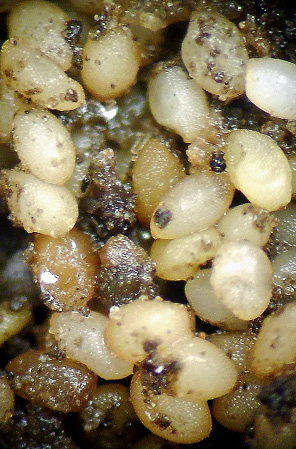
Figure 1. Corn rootworm eggs with close-up of a single egg.
V. Calles-Torrez, NDSU
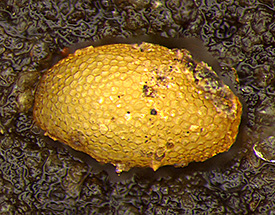
close-up of a single egg
P. Beauzay, NDSU
Larvae - Larvae (Figure 2) of both species are slender and white to cream with a brown head capsule and brown anal plate at the posterior end. Newly hatched (neonate) larvae are almost colorless. Larvae pass through three instars. The full-grown third-instar larva is about 1/2 inch (13 mm) long.
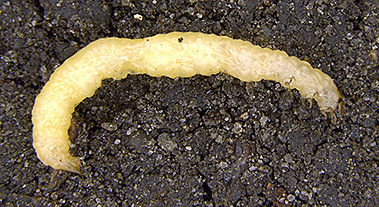
Figure 2. Corn rootworm larva.
P. Beauzay, NDSU
Pupae - The pupa (Figure 3) is translucent white to cream, and is similar in size and shape to the adult; however, it lacks fully developed legs and wings. The pupa is a resting and nonfeeding stage.
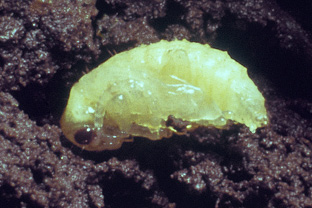
Figure 3. Corn rootworm pupa.
D. Keith, University of Nebraska-Lincoln
Adults - Adult corn rootworm beetles can easily be identified in the field. Northern corn rootworm adults (Figure 4) are tan to pale green, 1/4 inch (5.6 mm) long beetles. Western corn rootworm adults (Figure 5AB) are yellow to yellowish-green and black beetles. Most female western corn rootworm beetles (Figure 5A) have three longitudinal stripes on their forewings. In contrast, the forewings of most male western corn rootworm beetles (Figure 5B) have a nearly solid black marking. Western corn rootworm adults vary from 3/16 inch (4.2 mm) to 5/16 inch (6.8 mm) long. Female beetles of both species are usually slightly larger than males, and often have enlarged abdomens when carrying eggs inside of their abdomen.
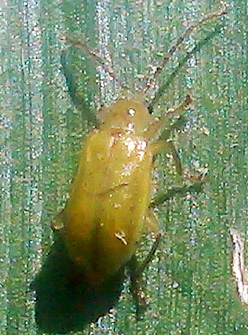
Figure 4. Northern corn rootworm adult.
V. Calles-Torrez, NDSU
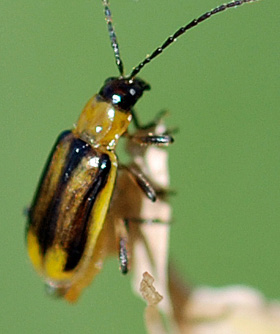
Figure 5. A. Female western corn rootworm adult.
J. Knodel. NDSU
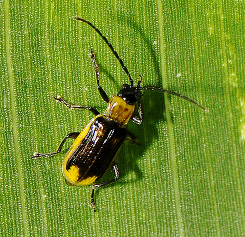
Figure 5. B. Male western corn rootworm adult.
P. Beauzay, NDSU
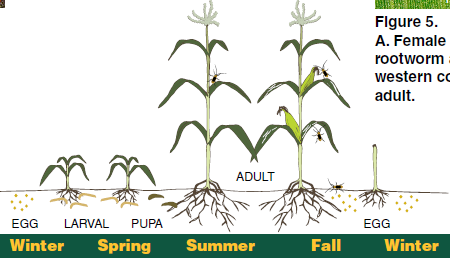
Life Cycle
Northern and western corn rootworms produce one generation per year. Although corn is the preferred host of northern and western corn rootworms, weeds such as volunteer corn in other crops and foxtail grasses can also be attractive to egg-laying females and can serve as an alternate host to larvae.
Corn rootworm adults usually begin emerging in mid-July in North Dakota. Northern corn rootworm beetles usually emerge first; western corn rootworm beetles emerge one to two weeks later. In North Dakota, 50 percent of adult emergence occurs by late August to early September, and it typically is completed by mid-October.
Male beetles emerge first, and female beetles emerge about five to seven days later. Female northern corn rootworm beetles mate within one to two days after emerging, whereas most western corn rootworm females mate within 24 hours after emergence.
Females feed for about two weeks after mating, after which they are ready to lay eggs. Most egg laying occurs from late July through September. A single northern corn rootworm female can lay more than 1,000 eggs in the growing season. Western corn rootworm females are capable of producing more than 1,800 eggs in a season.
Females lay eggs within the upper 8 inches (20 centimeters [cm]) of the soil surface. Some eggs will fail to survive due to several mortality factors, including predation, soil factors, extreme temperatures and excessive rainfall. Before eggs will hatch, they must undergo a long period in diapause, a slowed physiological state that allows them to overwinter. Eggs overwinter in the soil from September to June of the following year.
After overwintering, eggs hatch into larvae from late May through June in North Dakota. Soon after hatching, the tiny first-instar larvae orient to volatiles emitted from growing corn roots to find their host plants and begin feeding.
Larvae continue to feed as they develop, and reach maturity in the third instar. Mature third instars subsequently enter the pupal stage. Full-grown (third-instar) larvae pupate in earthen cells in the soil during early July. The transformation from pupae to adults takes about one week, with adults emerging from the soil beginning in mid-July.
Variation in the timing of egg hatch and developmental rates can result in overlaps of different corn rootworm life stages within a field.
Crop Injury
The most significant corn rootworm injury to corn occurs when larvae feed on the root system (Figure 6). First-instar larvae usually feed on root hairs and outer root tissue. Second instars feed on lateral roots and sometimes burrow into the roots. Mature third instars cause the most damage by feeding on lateral roots and often burrowing into the roots, often making longitudinal tunnels through the central core of the brace roots.
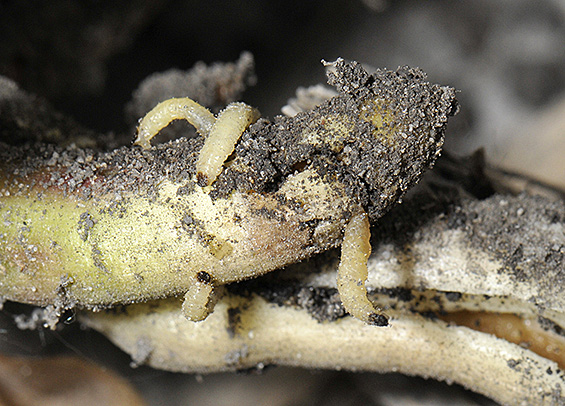
Figure 6. Corn rootworm larval feeding.
P. Beauzay, NDSU
Tunneling injury can result in completely severed individual roots. Feeding scars and the remaining tissues from severed roots (Figure 7) turn brown shortly after the injury. Injured root systems, especially those in which brace roots are heavily injured and/or severed, have reduced capacity to take up water and nutrients from soil.
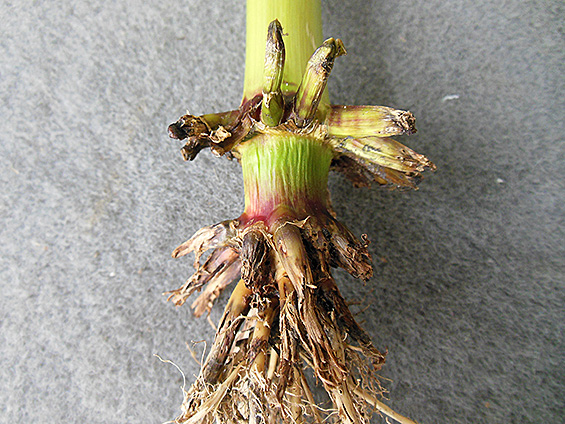
Figure 7. Corn root injury by corn rootworm larvae.
V. Calles-Torrez, NDSU
Severe larval root feeding injury can cause up to 50 percent yield losses. Severe corn rootworm feeding injury to roots also can cause plants to become weak and exhibit symptoms of water stress.
Severe injury to brace roots can cause plant lodging (Figure 8) that is often followed by “goose-necking”, which is a curved or bent-appearing stalk condition that results from plants attempting return to a vertical orientation following lodging (Figure 9).
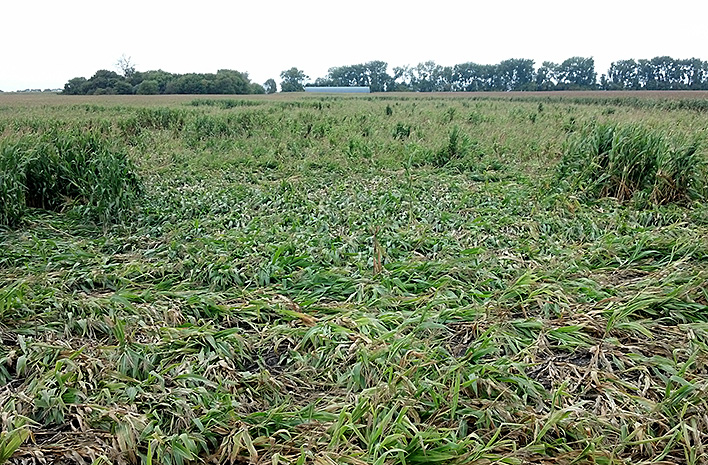
Figure 8. Corn plant lodging near Page, N.D.
J. Ransom, NDSU
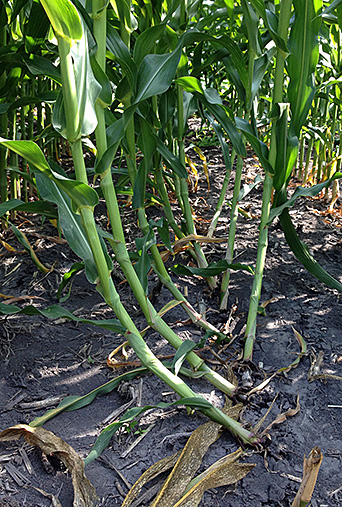
Figure 9. Lodged corn stalk showing goose-necking symptom.
J. Knodel, NDSU
Extensive plant lodging within a field can make harvesting difficult, resulting in additional losses. It should be noted that lodging can also be caused by other factors, such as severe winds, especially after a rainfall event, or feeding injury from other root-feeding insect pests. This underscores the importance of scouting for corn rootworm presence in fields exhibiting lodging symptoms.
Larval feeding injury can also predispose roots to plant pathogen infections, which can reduce overall plant health further.
Adults of both species will feed on corn leaves (Figure 10), silks (Figure 11), pollen (Figure 12), and kernels (Figure 13).
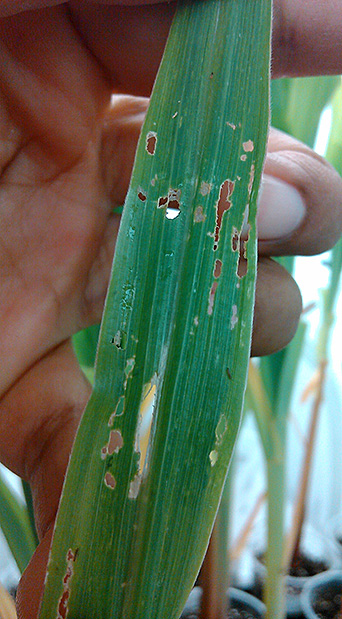
Figure 10. Adult corn rootworm feeding injury to leaf.
V. Calles-Torrez, NDSU
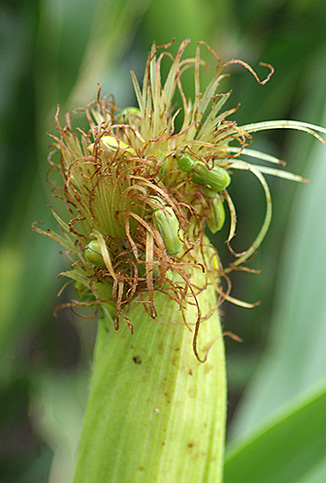
Figure 11. Northern corn rootworm adult feeding on corn silks.
V. Calles-Torrez, NDSU
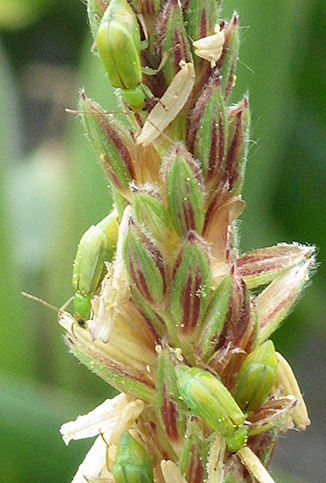
Figure 12. Northern corn rootworm adults feeding on corn tassel/ pollen.
V. Calles-Torrez, NDSU
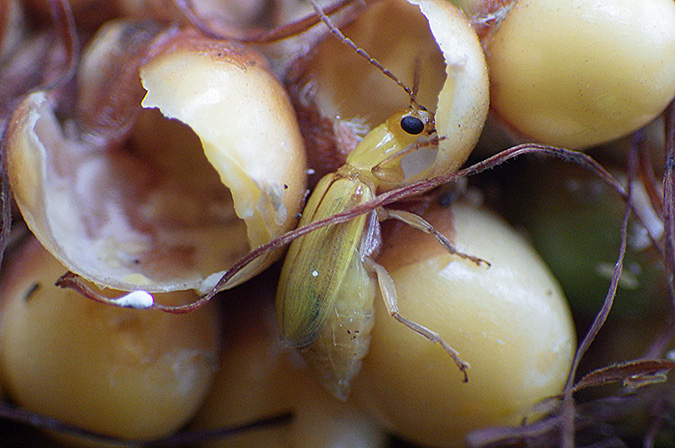
Figure 13. Northern corn rootworm adult feeding on corn kernels.
V. Calles-Torrez, NDSU
Leaves injured by corn rootworm beetles will have feeding scars (Figure 14) that look like scratch marks on leaf surfaces. Leaves also can have feeding holes (Figure 10) or can be totally stripped. High corn rootworm beetle infestations can cause additional yield losses by damaging corn silks, which interferes with pollination, and by feeding on developing kernels.
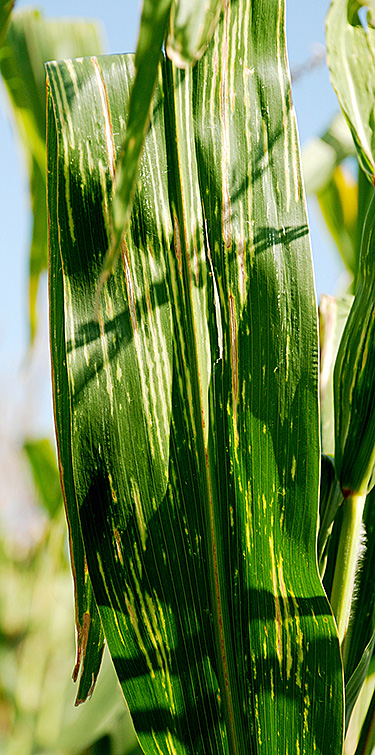
Figure 14. Leaf feeding scars by corn rootworm adults.
J. Knodel. NDSU
Monitoring and Thresholds
Monitoring for corn rootworm adults on above-ground tissues and larval feeding injury to roots, and the use of economic thresholds are important steps of the pest management decision-making process. Monitoring can reveal whether injurious populations are present and help determine which pest management strategy will minimize potential yield loss most effectively.
Corn rootworm larval sampling is recommended primarily for fields that have a history of damaging populations. Larval sampling also can be used to verify the success or failure of insecticide applications or rootworm-active transgenic corn hybrids, such as Bt (Bacillus thuringiensis) corn hybrids.
Larval Sampling
Soil Cube Sampling for Larvae
Sampling for rootworm larvae can be done by using the soil cube technique. In North Dakota, this sampling should be done between mid-June and mid-July. That’s when most larvae will be second or third instars, which are much easier to see than first instars.
Soil cube sampling involves the following steps:
- Randomly select one plant from each of 10 representative areas within the field.
- Use a knife to cut the plant stalk off at about 12 inches (30 cm) above the ground.
- Use a shovel or spade to cut a 7-inch (18 cm) soil cube around the base of the plant, leaving the plant at the center of the cube; make sure the shovel blade is inserted vertically into the soil to avoid cutting roots.
- Place an individual root and its associated soil cube on a 2- to 3-foot (0.6 to 0.9 meter [m]) square sheet of dark-colored plastic, cloth or tarp. The dark background makes light-colored corn rootworm larvae easier to see.
- Separate soil from roots slowly and carefully inspect it for rootworm larvae.
- Repeat the process for all samples, counting all larvae present, and calculate the average number of larvae per plant.
Threshold: Postemergence management of corn rootworm adults is recommended if the field averages two or more corn rootworm larvae per plant.
Adult (Beetle) Sampling
Before and During Pollination – Visual Counts for Adults
Adult Counts in Silk Masses – Begin field monitoring for corn rootworm adults a few days before the silking stage. Monitor corn plants by walking down corn rows and searching for adult beetles on the corn ear.
Adults are most active during midmorning or late afternoon, so scouting within these time periods is preferable. If no adults are found, then no further scouting is needed for three days. Continue to scout the field twice per week until pollination occurs.
If rootworm beetles are detected in the field, randomly select five nonconsecutive plants in five to 10 different locations throughout the field. Count and record the number of rootworm adults while keeping track of the number of plants sampled, and then calculate the average number of beetles per plant.
Threshold: If the field averages five or more beetles per plant during the first week of pollen shed, control with a foliar-applied insecticide is recommended to reduce pollination problems.
Assessing Silk Clipping – During pollen shed, randomly select five nonconsecutive plants from five to 10 representative locations within the field, and measure the length of the remaining silk that is protruding from the ear on each selected plant.
Threshold: If silks are clipped to within 1/2 inch (1.3 cm) of the ear tip on 25 to 50 percent of the total number of sampled plants, then control is recommended to prevent further silk damage. Yield is not affected if silk is clipped after pollination (brown silks); therefore, control will not be necessary.
After Corn Pollination – Adult Visual Counts to Determine Potential for Larval Problems Next Year
The potential for economic damage by corn rootworm larvae for the following year can be estimated by counting the number of adults on corn plants. Start scouting three weeks after pollination and continue once per week until silks are dry and brown.
Randomly select 10 nonconsecutive plants in 10 representative locations throughout the field for a total of 100 plants. During corn ear inspection, carefully cover the silk with one of your hands, then count the number of adults present by slowly allowing your hand to open. Gently disturb silks near the ear tip to dislodge and force beetles to exit.
Also check the stalk, upper and lower leaves, leaf axils and tassel for corn rootworm beetles. Pull leaves down when inspecting the leaf axils because adults often hide inside them. Count and record the number of adults of each species, then estimate the average number of adults per plant by species.
Threshold for first-year corn: Management in the following year’s corn crop is recommended if counts average two or more adults per plant for northern corn rootworm or one adult per plant for western corn rootworm.
Threshold for continuous corn: Management in the following year’s corn is recommended if a field averages three or more adults per plant for northern corn rootworm or 1.5 adults per plant for western corn rootworm.
If you find both species in the field, use the threshold for the predominant species. The threshold for first-year corn is less than continuous corn because the ratio of female to male adults is 70:30 in the first year and 50:50 in the continuous corn. Corn rootworm populations can take two to three years to build up and cause economic loss.
Monitoring Adults With Traps
Corn rootworm adults can be monitored using sticky traps. During early August, deploy 12 unbaited Pherocon AM® yellow sticky traps per 10 to 50 acres of corn. Traps should be arranged into two linear transects separated by at least 330 feet (100 m). The transects also should be at least 100 feet (30 m) away from field edges and/or waterways. Each transect should contain six sticky traps that are at least 165 feet (50 m) apart from each other.
Attach the sticky trap on the corn stalk at ear height (Figure 15). Replace traps once per week for four to six weeks, or until the threshold is reached. Count and record the number of beetles caught on each trap.
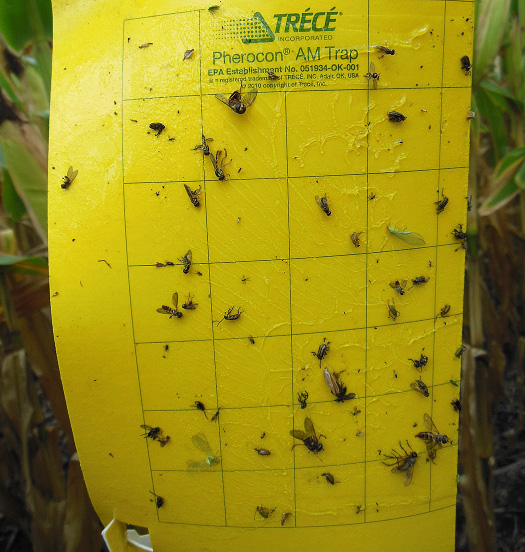
Figure 15. Sticky trap for adult corn rootworms (in circles) on the corn stalks at ear height.
V. Calles-Torrez, NDSU
Lastly, calculate the average number of beetles per trap per day (add total number of beetles captured from all traps and divide by total number of sticky traps, then divide this result by the total number of days that traps were deployed in the field).
Threshold: A capture rate of six or more beetles per trap per day indicates that a high corn rootworm population is expected the following year. As such, a corn rootworm management tool will likely be necessary to protect the following year’s corn crop.
Larval Root Feeding Injury Ratings
Quantifying rootworm larval feeding injury to corn roots can be helpful for verifying the success or failure of a soil insecticide or Bt corn hybrid, and it also can help determine the best pest management strategy to use in the following year.
To estimate the level of larval feeding injury in a cornfield, randomly select 10 plants throughout the field and excavate their roots in late August or early September. Most corn rootworm adults will have emerged by this time, so root feeding injury should mostly be completed.
Selecting plants that have been treated with the same management tool(s) is important. For example, in a field planted with Bt corn and its required refuge (non-Bt corn) in a block or strip near the field, select 10 plants from the Bt corn area and 10 plants from the non-Bt corn. Be careful not to mix plants from areas that received different management tools.
Dig roots from soil, taking care to avoid damaging them with the shovel. Soak roots in a bucket of water for 30 to 60 minutes, and then wash the soil from them. Be careful to avoid causing mechanical damage to roots during washing.
Once roots are cleaned, score root injury using the Iowa State 0-3 node-injury scale (Table 1). Calculate the average root injury rating to determine thresholds. One node pruned generally equates to a 15 to 18 percent yield loss.

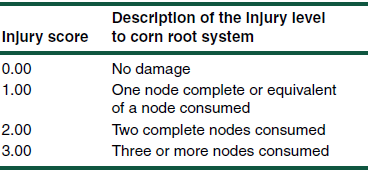
Table 1. Node-injury score for corn rootworms using an injury scale of 0.00 to 3.00.
A single root (for example, brace root) is counted as consumed if it is pruned back to within 1.5 inches (38 mm) of the stalk. Feeding between nodes is scored as the percentage of the complete node consumed; for example, 1.50 is equivalent to 1½ nodes consumed (Oleson et al., 2005). An uninjured corn root is shown in Figure 16A and can be contrasted with a damaged root from corn rootworm feeding injury in Figure 16B (rating of about 1.8). For an interactive visual node-injury scoring system, see the internet link by VanDyk (2005) in the Selected References section.
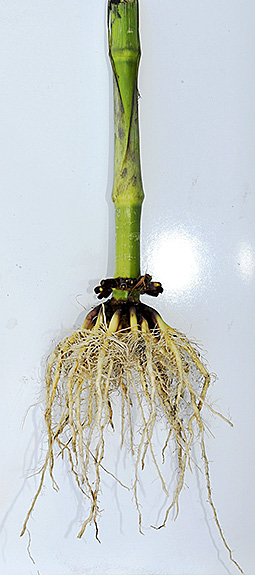
Figure 16. A. Healthy root with minimal corn rootworm feeding injury.
P. Beauzay, NDSU
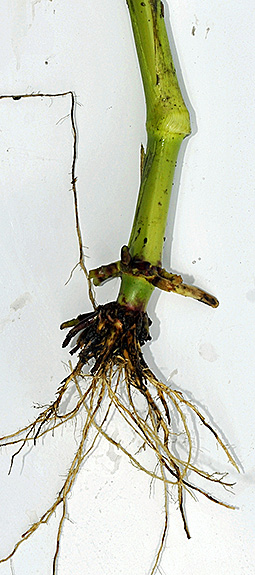
Figure 16. B. Root injured by corn rootworm larvae.
P. Beauzay, NDSU
Integrated Pest Management Strategies
Once a rootworm problem is confirmed, choosing the appropriate management strategy will depend on field history, species composition of the pest population, the presence/absence of localized resistance problems, financial and agronomic constraints. The benefits and limitations of various IPM strategies are discussed below.
Natural Control
Beneficial insects and related organisms that prey on or parasitize eggs, larvae or pupae of corn rootworms include ground beetles, rove beetles, ants, mites, spiders and centipedes. Spiders are capable of preying on adult corn rootworm beetles. These beneficial organisims are generally not effective in reducing rootworm populations below damaging levels. However, preserving beneficial organisms can enhance the impact of other tactics.
Cultural Control
- Crop rotation
Crop rotation is the No. 1 strategy for managing corn rootworm populations because it disrupts the year-to-year availability of corn, the pests’ primary host plant. Crop rotation also can help slow the development of resistance to other control strategies.
NDSU Extension encourages crop rotation with nonhost crops, such as soybeans, flax, sunflowers or wheat. Corn rootworms mainly depend on corn as a food plant, and larvae usually will starve to death on all but a few noncorn plants. As such, crop rotation can break the weak link of the corn rootworm life cycle.
- Adaptations of Corn Rootworms to Crop Rotation
Northern and western rootworm populations have adapted to crop rotation systems; however, each has adapted by a different mechanism.
The northern corn rootworm has adapted to crop rotation through extended egg diapause (the dormant period), in which some eggs remain in diapause for two or more winters. If corn is rotated annually with soybeans or another nonhost crop, extended-diapause eggs will hatch in the subsequent spring when corn is planted again in the field.
Northern corn rootworm populations with extended egg diapause occur in Minnesota, South Dakota, Iowa, Wisconsin and Nebraska. However, this adaptation has not been observed in North Dakota.
Some western corn rootworm populations have shown a behavioral shift, in which variant females in regions with intensive, near universal use of a corn/soybean rotation will lay eggs in soybean fields as well as corn fields. The eggs laid in soybean fields then hatch during the following growing season when the rotation returns to corn.
The behavioral shift by these western corn rootworm-variant females has been observed in Illinois, Indiana, Michigan and Ohio. Soybean-variant western corn rootworm populations have not been reported in North Dakota to date.
- Control of Volunteer Corn
Volunteer corn or other grassy weeds growing in other rotational field crops such as soybeans can be attractive to local corn rootworm populations for egg laying or adult feeding on silks, leaves or pollen. Females from North Dakota corn rootworm populations most likely will not lay eggs in fields without corn.
- Planting Date Modification
Early planted corn typically produces more vigorous root systems and higher yields. Planting corn early also can result in early silk development and pollination and, as such, allow these processes to occur before peak corn rootworm beetle emergence. This can minimize the risk of silk clipping and pollination interference.
In contrast, late-planted corn leads to later corn silk development and pollination, thus placing such fields at higher risk of significant silk clipping and kernel feeding injury. Late-planted fields also will be more attractive for egg laying by corn rootworm beetles, and therefore can be at increased risk of larval feeding injury during the following growing season.
Corn Hybrid Selection
Corn rootworm management can be achieved using transgenic (genetically modified) Bt corn, which has been modified to express a variety of crystalline (Cry) protein(s) derived from the bacterium Bacillus thuringiensis. The Cry proteins that have been engineered into Bt corn hybrids were selected because of their ability to kill corn rootworm larvae specifically as they feed on roots of Bt hybrids.
A Bt corn hybrid may express a single Cry protein or combination of multiple proteins, and can be engineered to target a single insect pest group (rootworm species) or multiple insect pests (corn rootworms and caterpillar pests such as European corn borer). Bt corn hybrids expressing a single protein, such as Cry3Bb1, mCry3A or Cry34/35Ab1, are specific to and kill only corn rootworms.
A Bt hybrid with two or more proteins targeting the same insect group, such as those expressing Cry3Bb1 plus Cry34/35Ab1 or mCry3A plus eCry3.1Ab, is called a “pyramid” because all of these proteins are specifically toxic to corn rootworms.
When a Bt corn hybrid contains two different protein types targeting separate insect pest groups, the hybrid is referred to as “stacked.” A Bt corn hybrid containing multiple rootworm-active Cry proteins and also protein(s) targeting other pest types (e.g., caterpillers), or vice versa, is called a “stacked pyramid.” Bt corn hybrids also can be stacked with a herbicide-tolerant trait.
When planting a Bt corn hybrid, always follow the instructions for planting refuge corn in the correct location and follow the area percentage requirements. Refuge seed will lack expression of the Bt protein that is used to control the target pest(s).
Some Bt corn hybrids are packaged as “refuge in the bag” (RIB) products, meaning the bag contains a mixture of non-Bt and Bt corn seeds in the proper ratio. If refuge seeds are not included in the bag, refuge seed must be planted adjacent to or within the rootworm-active Bt corn field. Planting non-Bt refuge is extremely important because it can help delay corn rootworm resistance to Bt proteins, thus extending the durability of this technology as a corn rootworm management tool.
If a Bt hybrid is used and unexpected corn rootworm populations or severe root injury occurs in a Bt corn field, contact the associated seed company and also NDSU Extension Entomology.
For guidance in selecting a suitable Bt corn hybrid, consult the “Handy Bt Trait Table for U.S. Corn Production” (DiFonzo et al. 2017) or the corn section of the “North Dakota Field Crop Insect Management Guide” (NDSU Extension publication E1143). A web link to this publication is included in the Selected References section of this document.
How to Prevent Bt Resistance Development in Corn Rootworms
The potential for corn rootworm resistance to Bt corn hybrids exists in North Dakota. Western corn rootworm populations already have developed resistance to several Bt proteins, including Cry3Bb1, mCry3A, eCry3.1Ab and Cry34/35Ab1 in Iowa and Minnesota.
The following strategies are recommended to reduce the risk of rootworm populations developing resistance to Bt proteins:
- Crop rotation - Rotate fields annually between corn and nonhost crops. If practical, rotate corn from the field for two to four years.
- Control volunteer corn and grassy weeds that could serve as hosts for local Bt-resistant rootworm populations.
- Plant a conventional (non-Bt) corn hybrid and use a soil insecticide instead of a Bt hybrid, especially when rootworm pressure is expected to be low. Note: combining a Bt hybrid with a soil insecticide is not recommended because the soil insecticide does not provide any additional yield protection due to the Bt protein killing rootworms. This practice also prevents detection of Bt-resistant insect populations.
- Plant the non-Bt corn refuge according to guidelines on the Bt corn seed bag tag.
- Rotate fields with Bt corn hybrids that have different modes of action each year. For example, use a Cry 3 Bt corn hybrid (for example, Cry3Bb1, mCry3A or eCry3.1Ab) the first year, then switch to a Bt corn hybrid expressing a different mode of action (for example, Cry34/35Ab1) in the subsequent year.
- n Be vigilant in scouting fields for corn rootworm adults, and assess larval root-feeding injury.
- n Report suspected performance problems immediately to your local seed dealer and to NDSU Extension Entomology.
Warning Signs of Emerging Corn Rootworm Bt Resistance
- High population density of corn rootworm adults in Bt corn fields during late summer
- Severe leaf-feeding injury; silk feeding by adults in Bt corn fields
- Rootworm node-injury scores of at least 1 (or one complete node consumed) on Bt corn hybrids with a single Bt protein, or 0.5 on pyramided Bt corn hybrids
- Significant corn plant lodging or goose-necking present in Bt corn fields
It is important to keep accurate records each year for individual planted fields and their locations. Important information includes corn hybrid(s) planted, larval root-feeding injury scores by hybrid, and rootworm adult counts per trap or per plant.
Early detection of corn rootworm resistance to Bt corn will reduce the risks of economic loss and will help promote the sustainability of this technology for rootworm management in your area.
Chemical Control
Remember to use the recommended thresholds before deciding to use a chemical insecticide. Insecticides come in granular or liquid forms and can be applied at planting as soil insecticides or postemergence as foliar insecticides.
Planting-time soil insecticide applications can be placed in-furrow or as t-bands for control of larvae, and as foliar applications for adult control. Soil insecticides provide a zone of protection around roots and typically result in about 70 percent larval mortality. Insecticidal seed treatments also are available but provide minimal protection from corn rootworm larval root feeding. They mostly are intended for control of secondary pests, such as wireworms and white grubs.
The use of foliar insecticide applications to control adults is uncommon in North Dakota. If more than one application of foliar insecticide is made, rotate the class of insecticide to prevent rootworm populations from developing insecticide resistance.
Hot, dry weather conditions will favor spider mite outbreaks in corn. To prevent such spider mite “flares,” avoid using pyrethroid insecticides for adult rootworm control (except for products containing the active ingredient bifenthrin). The pesticide label is a legal document, so applicators must read, understand and follow all label directions.
For help with selecting a registered insecticide for corn rootworm control in North Dakota, consult the current “North Dakota Field Crop Insect Management Guide” (NDSU Extension publication E1143). The web link to this document is listed below in the Selected References section.
Selected References
DiFonzo, C., P. Porter and K. Tilmon. 2017. The handy Bt trait table for U.S. corn production (updated March 15, 2017). Michigan State University, East Lansing, Mich. Field Crops Entomol.
Knodel, J.J., P. Beauzay and M. Boetel. 2016. North Dakota field crop insect management guide. NDSU Extension Service, E1143 (Revised).
Levine, E., J.L. Spencer, S.A. Isard, D.W. Onsted and M.E. Gray. 2002. Adaptation of the western corn rootworm to crop rotation: evolution of a new strain in responses to a management practice. Am. Entomol. 48: 94-107.
Oleson, J.D., Y.L. Park, T.M. Nowitzki and J.J. Tollefson. 2005. Node-injury scale to evaluate root injury by corn rootworms (Coleoptera: Chrysomelidae). J. Econ. Entomol. 98: 1–8.
Tooker, J. and C. DiFonzo. 2013. Managing western corn rootworm resistance to Bt on the fringe. Entomological Notes, Pennsylvania State University.
VanDyk, J. 2005. Interactive node-injury scale (updated March 2, 2005). Iowa State University, Ames, Iowa.
Published with support from North Dakota Corn Council.

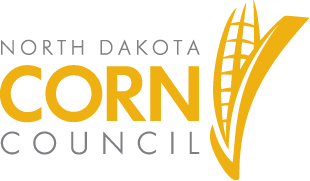
June 2017

